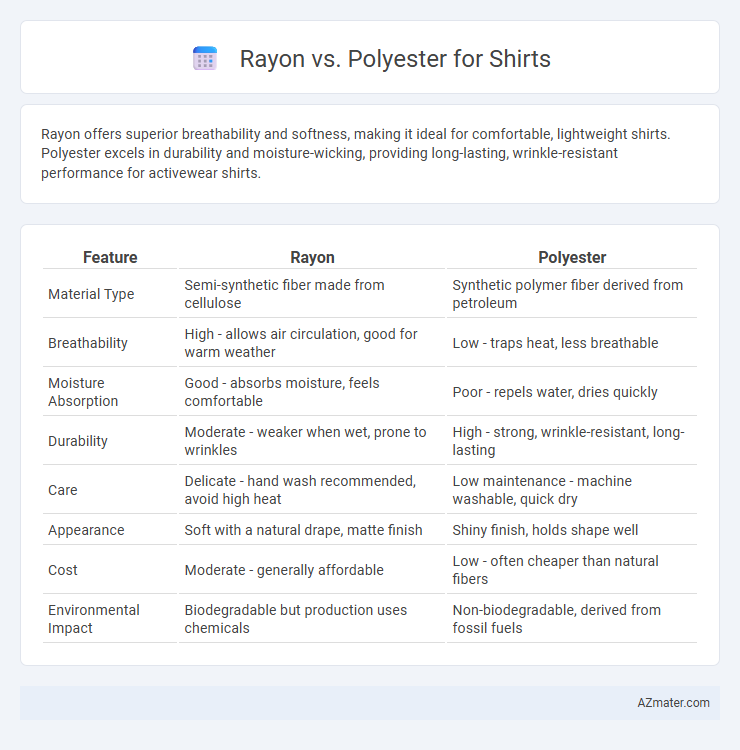Rayon offers superior breathability and softness, making it ideal for comfortable, lightweight shirts. Polyester excels in durability and moisture-wicking, providing long-lasting, wrinkle-resistant performance for activewear shirts.
Table of Comparison
| Feature | Rayon | Polyester |
|---|---|---|
| Material Type | Semi-synthetic fiber made from cellulose | Synthetic polymer fiber derived from petroleum |
| Breathability | High - allows air circulation, good for warm weather | Low - traps heat, less breathable |
| Moisture Absorption | Good - absorbs moisture, feels comfortable | Poor - repels water, dries quickly |
| Durability | Moderate - weaker when wet, prone to wrinkles | High - strong, wrinkle-resistant, long-lasting |
| Care | Delicate - hand wash recommended, avoid high heat | Low maintenance - machine washable, quick dry |
| Appearance | Soft with a natural drape, matte finish | Shiny finish, holds shape well |
| Cost | Moderate - generally affordable | Low - often cheaper than natural fibers |
| Environmental Impact | Biodegradable but production uses chemicals | Non-biodegradable, derived from fossil fuels |
Introduction to Rayon and Polyester
Rayon, a semi-synthetic fiber made from regenerated cellulose, offers a soft, breathable feel ideal for comfortable shirts, while polyester, a fully synthetic fiber derived from petrochemicals, is known for its durability, wrinkle resistance, and moisture-wicking properties. Rayon fabrics excel in drape and breathability but tend to wrinkle and shrink more easily, whereas polyester shirts maintain shape and resist stains with long-lasting color retention. Understanding the differences between rayon and polyester helps consumers choose shirts that balance comfort, appearance, and maintenance according to their lifestyle needs.
Understanding the Fabric Origins
Rayon, derived from natural cellulose fibers typically sourced from wood pulp, offers a semi-synthetic alternative that mimics the softness and breathability of natural fabrics. Polyester, a fully synthetic fiber produced from petrochemicals, provides high durability and resistance to wrinkles and shrinking. Understanding these fabric origins helps in choosing shirts based on sustainability preferences, comfort needs, and performance characteristics.
Key Characteristics of Rayon Shirts
Rayon shirts are known for their breathability, softness, and excellent moisture absorption, making them ideal for warm weather and active wear. The semi-synthetic fiber mimics the texture of natural fabrics like cotton or silk, providing a smooth, comfortable feel against the skin. Rayon's drapeability and vibrant dye retention ensure a stylish, flattering fit with rich color vibrancy compared to polyester, which tends to be less breathable and more prone to retaining odors.
Key Characteristics of Polyester Shirts
Polyester shirts are known for their durability, wrinkle resistance, and moisture-wicking properties, making them ideal for active wear and everyday use. The synthetic fibers provide excellent color retention and quick drying, ensuring long-lasting vibrancy and comfort. Polyester fabrics are also lightweight and resistant to shrinking and stretching, offering a consistent fit over time.
Comfort Comparison: Rayon vs Polyester
Rayon offers superior breathability and softness, making it highly comfortable for shirts worn in warm weather due to its moisture-absorbing properties. Polyester, while durable and wrinkle-resistant, tends to trap heat and moisture, which can result in less comfort during prolonged wear. For individuals prioritizing comfort and a lightweight feel, rayon is generally preferred over polyester.
Breathability and Moisture-Wicking Abilities
Rayon offers superior breathability compared to polyester due to its natural cellulose fibers, allowing air to circulate and keep the skin cool. However, polyester excels in moisture-wicking capabilities by quickly drawing sweat away from the body and drying faster. Choosing between rayon and polyester for shirts depends on prioritizing comfort in ventilation versus efficient moisture management during physical activities.
Durability and Maintenance
Polyester shirts offer superior durability due to their resistance to abrasion, stretching, and shrinking, making them ideal for long-lasting wear. Rayon, while softer and more breathable, tends to be less durable and requires delicate care to prevent damage such as shrinking or fabric weakening. Maintenance of polyester is easier as it is wrinkle-resistant and machine-washable, whereas rayon demands gentle hand washing or dry cleaning to preserve fabric quality.
Environmental Impact and Sustainability
Rayon production relies heavily on cellulose from trees, causing deforestation and significant water pollution due to chemical-intensive processing, raising concerns about sustainability. Polyester, derived from petroleum, contributes to fossil fuel depletion and microplastic pollution, posing long-term environmental challenges. Biodegradability is low for both fibers, but advances in recycled polyester manufacturing and sustainable rayon sources like bamboo offer potential improvements in eco-friendliness.
Cost and Market Availability
Rayon shirts often come at a higher cost due to the complex manufacturing process and limited production scale compared to polyester. Polyester dominates the market with widespread availability and lower prices, benefiting from mass production and synthetic fiber efficiency. Cost-conscious consumers frequently choose polyester for its affordability and easy accessibility across various retailers.
Which Fabric is Better for Shirts?
Rayon offers superior breathability and softness, making it ideal for shirts that prioritize comfort and moisture-wicking properties. Polyester excels in durability, wrinkle resistance, and color retention, which suits shirts designed for long-lasting wear and easy maintenance. Choosing between rayon and polyester depends on whether comfort or durability is the primary requirement for the shirt.

Infographic: Rayon vs Polyester for Shirt
 azmater.com
azmater.com